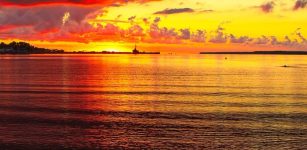Arctic Cloud Movement Study May Improve Regional Climate Change Understanding
Eddie Gonzales Jr. – MessageToEagle.com – Special features of the Arctic climate, such as the strong reflection of the sun’s rays off the light snow or the sun’s low position, amplify global warming in the Arctic.
However, researchers are often faced with the challenge of modeling the underlying climatic processes to be able to provide reliable weather forecasts.
Illustration of the quasi-Lagrangian approach adopted during the HALO–(????)3 aircraft campaign. Credit: Atmospheric Chemistry and Physics (2024). DOI: 10.5194/acp-24-8865-2024
Scientists from the HALO (𝒜𝒞)³ aircraft campaign have succeeded in precisely measuring the movement of air masses from and to the Arctic. This will contribute to a better understanding of the processes accelerating climate change in the region. Their research has been published in Atmospheric Chemistry and Physics.
“We want to make fundamental and ground-breaking progress in our understanding of Arctic amplification and improve the reliability of models for predicting the dramatic warming in the Arctic,” says Professor Manfred Wendisch, Director of the Institute for Meteorology at Leipzig University and lead author of the study.
In mid-March 2022, the large-scale international research campaign HALO (𝒜𝒞)³ began its investigation of changes in air masses in the Arctic. Researchers from Leipzig University and several other research institutions are involved.
During the campaign, they used special aircraft to study the movement of air masses to and from the Arctic via northward moist- and warm-air intrusions (WAIs) and southward marine cold-air outbreaks (CAOs).
Two low-flying aircraft and one long-range, high-altitude research aircraft were flown in close formation whenever possible. “We observed air mass transformations over areas of open ocean, the marginal sea ice zone and the central Arctic sea ice,” says Wendisch.
The HALO (𝒜𝒞)³ aircraft campaign was conducted over the Norwegian and Greenland Seas, the Fram Strait, and the central Arctic Ocean in March and April 2022. A new observation strategy was used to track the changes in the air masses. This enabled the researchers to measure the moving-air parcels twice along their transport pathway.
“This allowed us to quantify the warming and cooling of the transported air masses for the first time. For example, we have shown that cold air that breaks out of the Arctic and heads south warms up to three degrees Celsius per hour on its way from the sea ice to the open sea. In addition, the humidity of the air increases as it moves south,” says Wendisch.
The scientists also studied changes in cloud properties as air masses are transported. This unprecedented data is currently being compared with calculations from the German weather forecast model.
Written by Eddie Gonzales Jr. – MessageToEagle.com Staff Writer











